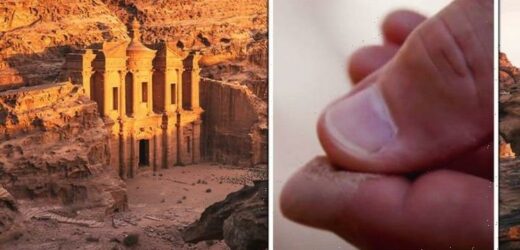Ancient city of Petra: Did a flood wipe it out?
We use your sign-up to provide content in ways you’ve consented to and to improve our understanding of you. This may include adverts from us and 3rd parties based on our understanding. You can unsubscribe at any time. More info
Petra and its lost ancient civilisation has perplexed researchers for years. It was once a thriving hub of politics, culture and economics — one of the most important waypoints of the region. The Nabateans inhabited the city that is located in what is now southwestern Jordan, and quickly amassed an envious amount of wealth that attracted the attention of the neighbouring Greek Empire, which unsuccessfully attempted to capture Petra in 312 BC.
This was the first reference to the city ever recorded in history.
When the Romans arrived in 106 AD, however, the Nabateans were unable to fend them off, and were forced to surrender.
Petra was annexed and renamed Arabia Petraea, and the Romans ruled over the city for the next 250 years.
But in the fourth century AD a massive earthquake hit, ripping the city apart and forcing its importance to decline just as sea trade routes emerged.


Later on, during the Byzantine era, several Christian churches were built, but the city continued to wane in significance.
The earthquake, then, has been attributed as the sole reason for Petra’s demise.
Yet, some archaeologists believe there is more to the story.
This includes Dr Tom Paradise, who has worked at Petra and spoke during the Smithsonian Channel’s documentary, ‘Secrets: Riddle of Petra’.
Through his analysis and excavations, he believes that Petra was victim to another “form of catastrophe” at some point in its history.
JUST IN: Archaeologists stunned as Tower of Babel story questioned

Along Petra’s collonaded main street, his team of archaeologists investigating a line of shops in 2017 came across something puzzling.
Dr Paradise explained: “What they uncovered [were] massive beds of very white sandstone.”
Showing a piece of the brick red sand that is native to the valley, he said: “It’s much more characteristic of the lower part of the valley.”
Yet, he picked up sand from another pile, which was found in the shops, and explained: “This characteristic white sand doesn’t belong here.”
The valley in which Petra sits is exclusively surrounded by hills of red rock.
Dr Paradise and his team set to work investigating the mystery.
He said: “We realised it had the particle size, the colour texture, everything the same as the sandstone that we see across the valley and over the top of the hill.
“This started a longer inquiry that would lead us to conclude that Petra may have literally been hit by a massive, massive flood.”
Petra has a history of being hit by torrential rains and subsequent flooding.
In 1963, its flood defences succumbed to floodwaters and killed 22 visitors.
DON’T MISS
Archaeology: City of Petra potentially destroyed ‘by massive flood’ [REPORT]
Pompeii breakthrough as ‘sensational discovery’ made near Roman town [INSIGHT]
Scuba diver finds 900-year-old Crusader sword [ANALYSIS]


The people who once inhabited Petra were all too aware of the dangers of flash flooding, and so installed a series of tunnels and offshoots to control excess surface water.
The Siq — Petra’s main entrance — was vital to the city, as it was the main connection to the outside world.
Dr Paradise explained: “What was actually a brilliant plan was that the tunnel was created to divert the water from the main siq.
“So the primary corridor into the main city would have been kept free of water during episodic rains.”
On the surface, it seemed like “fool-proof engineering”, but on closer inspection, Dr Paradise found evidence that at some point, water was massively backed up near the entrance.

He said: “The far side of the channel is completely scoured clean, so the water would have been rushing down the channel.
“It’s backed up by the obstruction in the tunnel, and it’s rising to the point where it starts to scour the side walls, and then literally tops the bank way up there, and you can see where it’s rounded.
“We’re looking at five, six, seven metres of floodwater just at this point, and that would have been an extraordinary amount of water.”
If Dr Paradise’s theory is correct, floodwater would have backed up into the city and filled the streets with up to 16 feet of sand and debris.

Petra was finally abandoned in the eight century.
Nomadic shepherds used the vast buildings cut into the rock face as shelters.
It wasn’t until 1812 that Swiss explorer Johann Ludwig Burckhardt came across the ruins during one of his trips.
After this, western explorers and archaeologists also made the journey, and a formal project to excavate and survey Petra was soon launched.
Source: Read Full Article


